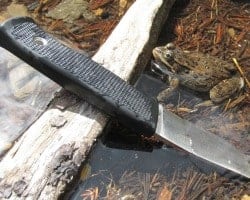
Tenacious would be a good word to describe the Fallkniven F1. In fact, it would be the perfect word. When survival is on the line, you want a blade that has tenacity in its job description. And the folks at Fallkniven F1 know how to build tenacity into a knife. Since its introduction in 1995, the Fallkniven F1 has not only set a standard for survival knives, but also sold over 100,000 copies of the original unfortunately spurring a cottage industry of counterfeits and copycats. Of course being a highly visible military issue knife helps, but globally, the F1 has a reputation that is enviable.
| KNIFE | DETAILS | ||
|---|---|---|---|

Recommended
|
|
Check Price on Amazon.com
|
SKIP AHEAD
Fallkniven F1 Survival Knife Review
The Little Brother
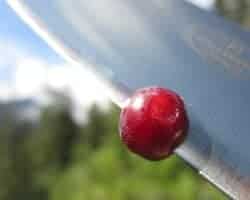
While noticeably smaller than its famous big brother the Fallkniven A1, the F1 is no less the fighter. With a laminated steel blade and extended full tang, the F1 provides the comfort in hand that many other survival knives can only claim in advertisements. And it is the steel that sets this knife apart from its doppelgangers. However, appreciating a übersteel is not something you can do in a store, or through pictures and video on the internet. Instead the F1 must be experienced to realize the potential of this top-shelf blade.
With a street price about a quarter-click north of a Benji, the F1 is easily in striking distance for many who are looking for a high end but affordable blade. The nosebleed sticker shock of custom knives often overshadows their performance making the price too high to ignore and thus derailing any productive discussion. But with the Fallkniven F1, you can get custom quality at a price well inside reasonable limits.
Also Read: 7 Things You Should Consider When Buying A Survival Knife
The F1 (with F as in Flight, and flight as in flight survival knife) has many features buried deep within its majestically simple design. From the moulded Thermorun handle, to the VG10 supersteel laminated blade, to the convex grind, to the bland but effective Zytel sheath. The F1 system is a professional pilot’s survival knife that will easily exceed the needs of a professional survivalist.
What’s in a Name?

It’s a sad fact that marketing a knife to the English speaking world usually requires a brand name with two or fewer syllables. Once a company hits three syllables, with Spyderco the possible exception, the knife brand seems exotic. Monosyllabic grunts like Buck, SOG and Case are easy winners, with complex double-grunt names like KA-BAR, Benchmade, Kershaw, and Gerber refusing to put up much of a linguistic fight. But what fun is there in owning a knife whose name you cannot even pronounce, let alone spell? And this comes from a guy who knows the words to the second stanza of his country’s National Anthem (but not the third or fourth). The blade of the Fallkniven F1 is one of those few hardware pieces in my kit that could just as easily be on display in an art museum. The sensuous concave grind. the stark transition between steel and grip. The fluid, unbroken lines of the blade’s business side. But I digress.
Blade Wisdom
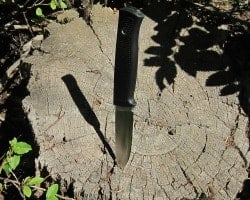
The handle is made of a lightweight thermoplastic called Thermorun. As an olefin thermoplastic material it is extremely durable, and has great properties for a survival knife grip. Thermorun is an electrical insulator, resistance to weathering, impervious to most chemicals that a knife would encounter, and pretty much ignores temperature changes. It feels great in the hand with just enough rubbery texture to keep the blade from sliding around, but still firm enough to avoid that tacky feeling of soft plastic grips.
One real-world test for the F1 occurred while in a 13 mile hike. As the mountain trail climbed steadily up the valley to a set of high mountain lakes buried deeply in a cirque, it also crossed through dozens of huckleberry patches. Huckleberries are a staple for grizzly bears, but unfortunately we didn’t see any that day. For mile after mile I used the F1 to cut branches, shave sticks, and chop small limbs. In essence, I spent hours cutting, slicing and shaving with the blade, and sliced huckleberries in half every mile or so. That latter task was used to monitor the sharpness of the edge throughout the day. And I am happy to report that the blade cut just as well at dusk as it did at dawn.
Stone Cold
Since survival is not just a warm weather sport, I tested the F1 along with some of its friends in a icy challenge. I placed the F1 a cookie sheet of water along with a G10-handled Benchmade Bushcrafter, a polymer plastic-handled Glock field knife, a micarta-handled Ontario Falcon knife, and a rubbery-handled Kershaw skinning knife. Before placing the tray in the freezer, I played around with each one noting the changes in grip friction when wet. I already knew the F1 performed wonderfully when soaked because when I finally arrived at the high mountain lake mentioned above, I took some time to test the cutting prowess of the F1 while underwater. It must have been an exciting test because a frog hopped over to watch the action.
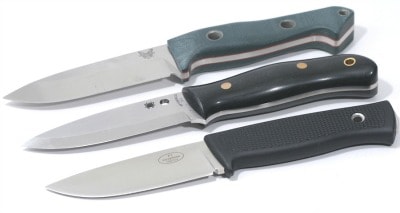
Twenty-four hours after entering the freezer I pulled out the tray out and broke the knives free from their icy confines and put them to work. The reason I used a cookie sheet was to bathe only part of the handle in ice since ice feels like ice so a completely covered handle would not tell me much. I was interested in the interface of human hand and the complicated relationship somewhere between wet and frozen. My earlier F1 water test proved that the Thermorun grip couldn’t care less if it was wet or dry. Gripping the F1 in any direction was just as solid when wet, and it actually surprised me how little the texture changed when damp. I was expecting at least some lubrication effects from the clear cold mountain water, but the only difference was the handle was wet. It did not slide around, nor feel the least bit unsure in a normal handgrip. But in hindsight, I suspect that was the point in specifying Thermorun for the handle. Fallkniven seems to have done their homework.
Also Read: Fallkniven A1 Survival Knife Review
The frozen blades were a mixed bag. For starters, the micarta handle was like trying to hold on to a popsicle. Well, maybe not quite that bad, but close. The smoothness of the Ontario Falcon handle was just was amplified by the frozen water. Some have complained of micarta scales being too smooth on the Falcon, and frankly, I’d be a little hesitant to attack a task with the slimy feeling micarta in my hand.
The Glock grip was relatively unchanged, which can be taken several ways. Like a Glock pistol (presumably of the same polymer as the knife), the handle remained just as hard and slippery as it does when dry. Not really bad, but those of us who have been Glock fans since the 1980s know that Glock has had several revisions of it pistol grip textures and still left a gaping hole that the aftermarketeers have swarmed in to fill.
The Benchmade actually put up a good fight with the cold. The G10 did not assume any additional negative characteristics, but did hold and transfer the cold feeling of the handle more than the less dense options. The thermal conductivity of G10, as well as its linear expansion coefficient is excellent compared to the mainstream materials used in lesser knives, but except for the Glock, we are playing with the Big Boys in knife grip technology.
The Kershaw was a disappointment, but I already knew that. It seemed to assume the negative characteristics of the ice becoming harder, more slippery, and less hand-friendly than ever before. Fixed blade Kershaw hunting knives are still a bargain in my book, but only in the world of occasional users and gifts. Any serious user will rapidly hit the Kershaw’s limits of steel type and handle performance.
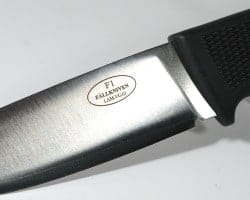
Regarding the F1, its icy performance was close to the Benchmades, but more grippy. Given that the most southern point of the F1’s country of residence is still over 55 degrees north of the equator (Smygehuk, in case you are wondering), I would have thought that subzero performance would be a priority, but compared to my earlier tests of the F1’s biggest brother, the Fallkniven A1’s Kraton grip retained much of its rubbery feel even when frozen while the Thermorun handle on the F1 felt rather harsh and definitely lost some of its grippy texture. However, after only a few moments in my bare hand, all its great qualities returned. If in a sustained cold environment where gloves were rule, the interface between knife handle and glove would be dependent on your choice of glove and not a as generalizable as the skin to Thermorun interaction.
| KNIFE | DETAILS | ||
|---|---|---|---|

Recommended
|
|
Check Price on Amazon.com
|
Finally, the Specs
I hesitate to reduce a knife to it’s specifications since, if you are at all like me, you can eyeball a knife and know if it has any chance of meeting your needs or desires. When I see tanto blades, I yawn. Clip points are interesting, but what really stokes my fire are beefy drop points. Very rarely do fully appreciate anything in the reverse, needle, or trailing point variety. Although I do hold mild appreciation for sheeps foot and spear points, its not blade racism, its just the way I roll. Outdoor tasks here in the boonies of Montana don’t often require an offensive blade. Instead a working blade shape is the call of duty. Street fighting steels usually require streets, and since many of my streets are dirt roads, I need a knife that behaves accordingly.
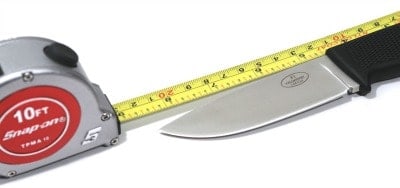
The gory details of the Fallkniven F1 include:
Total length: 210 mm or 8.3″
Blade length: 97 mm or 3.8″
Blade thickness: 4.5 mm or 0.18″
Steel hardness: ~59 HRC
Steel: Laminated with a core of VG10
Tang: Full, extended.
Weight: 150 g or 6oz
Handle material: Thermorun plastic
Sheath material: Zytel plastic with nylon strap and metal snap
Of note in the above list is that the knife is fairly light for a fixed blade over eight inches long. And at six ounces, the F1 is on the heavier side of a folding knife. The famous Benchmade Adamas folders weigh in at 7.7 ounces making it noticeably heftier than the F1. Another point to highlight is the blade thickness at almost a fifth of an inch. While not knocking anyone’s socks off, the thickness is plenty on a 3.8” blade since blades almost twice that length only up the thickness by a half-dozen hundredths.
The VG10, or V Gold stainless 10 steel is forged in Japan. While it might be nice to forge your own steel and thus keep everything in-house, in my book it is better to source your materials from the experts, and frankly, the Japanese have a rather large head start on most other steel manufacturers when it comes to metal we want in our blades. VG10 is nothing new to those folks immersed in quality knives, but for those just arriving, VG10 is a cutlery-caliber stainless steel that has proved itself worthy for sporting blades as well as professional kitchen knives. Fallkinven uses VG10 in its higher end blades, but not in its highest end. But the price point of its special steels like those cobalt alloys are far beyond the buck-and-a-quarter that Amazon charges for the F1. If you want the top-shelf metals, expect to pay used car prices.
Conclusion
Finally, if you subtract the blade length from the overall knife length of the F1, you will see that over half this knife is grip. While there is a generally accepted minimum grip size, the F1 has an excellent balance between control surface and cutting surface. The F1 follows the commands you give it with the headquarters at the index finger. The rest of your hand provides a firm home for blade operations, but precision is located squarely where it should be, at the first finger interface. Bigger fighting blades are controlled by more of the hand, while surgical blades demand a more pencil-pinching finesse. The F1, however, stabs like a beast, but can back off to embrace the precision of a heavy scalpel when needed. Since the demands of a survival knife range from everything on one end to everything on the other, decisions have to be made. In the case of the F1, you get the best of most worlds. Unless massive force is needed, the F1 should be at the top of your short list of survival blades.
| KNIFE | DETAILS | ||
|---|---|---|---|

Recommended
|
|
Check Price on Amazon.com
|
All pictures taken by Doc Montana

